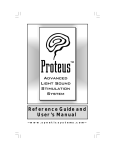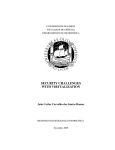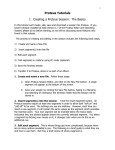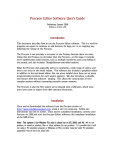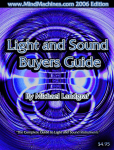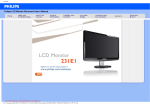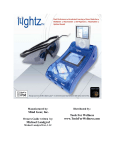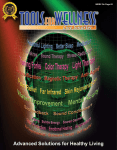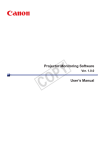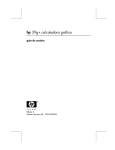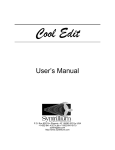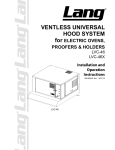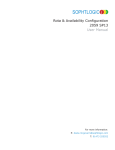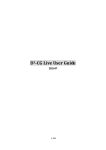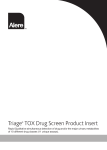Download Proteus Manual 3 half final.pub
Transcript
Reference Guide and User’s Manual Rev. 3, June 2006 www.mindplace.com Copyright © 2006 by The MindPlace Company. All rights reserved. Proteus, LightFrame, and Color Crossfades, are trademarks (TM) of MindPlace. AudioStrobe is a registered trademark ® of AudioStrobe GMBH. Proteus™ Audio Visual Stimulation System User’s Guide Rev. 3.0, June 2006 Congratulations! You now own the most advanced light sound stimulation system (LSS) available on the market today. Proteus offers several major advances over earlier models: MultiColor LightFrames™. Now you can take advantage of the correlation between color and mental state: green for tranquility, red for activation, and more than 250 combinations of the two. Plus, the visual effects are much more intense than with old-fashioned monocolor systems! Patent pending. Improved AudioStrobe® compatible decode circuitry. We’ve added sophisticated new circuitry for a more subtle and expanded experience when playing AudioStrobe CDs and those using a similar encoding format. PC Connection. Connect Proteus to your computer (Windows 98 or later) and transfer new programs into the system with the included serial transfer cable. Requires a DB-9, RS232 connector on your PC, or a serial to USB converter (not supplied). Large program store. Two nonvolatile memory banks can hold up to 199 sessions and four audio waveforms at one time. All can be edited with downloadable Proteus Editor software. Proteus ships with 50 sessions preprogrammed in its READ THIS BEFORE USING PROTEUS Proteus is intended for use as a tool for enhancing consciousness and for personal growth. It is not intended for use as a medical diagnostic or therapeutic device, and no medical claims of any sort are made for it. DO NOT USE THIS PRODUCT without your doctor’s specific guidance if you or any family member has ever experienced any form of seizure disorder, such as epilepsy, or if you are or have been taking any form of psychoactive drug, such as amphetamines, barbiturates, etc. 3 main (Pxx) bank, and 14 ThoughtStream-controlled sessions in its Utility (Uxx) bank. Note that these programs can be used as normal light and sound programs when a ThoughtStream is not connected to it. Free session creation software. Download our free Proteus Editor program from www.mindplacesupport.com and create your own sessions, edit audio waveforms (including single and dual binaural beats), build your own downloadable “albums”, etc. Introduction Your Proteus package should include the following items: · · · · · · · Proteus console Headphones MultiColor LightFrames™ PC-connect cable (DB9 serial to stereo mini) Stereo audio patch cord Handy carry case This manual You will also need three “AA” alkaline batteries, not included. Setting your system up and running your first session Step 1: Install the batteries · · · Remove the sliding battery cover from the back of Proteus by pressing gently and sliding downwards. Install three alkaline “AA” batteries. Be sure to observe proper orientation. Replace the battery cover. Step 2: Connect the LightFrames and headphones 4 · · Plug the LightFrames into the top of the unit. Plug the headphones into the jack on the right side of the unit that is nearest the top. Step 3: Select a session · · Turn the unit on using the slide switch on the upper right side of the console. The display will initially display the current code revision, then “P01”. Press and hold the bottom button; notice that the display reads “P02”, etc., indicating which program has been selected. When the session you wish to run appears on the display, release the button. Step 4: Start the session and adjust brightness and volume · · · · Sit or lay down in a quiet, comfortable location. Press the Start/Stop (top) button to start a session. Be sure to close your eyes while the LightFrames are on! The lights can be quite bright. You may also need to adjust the position of the LightFrames on your nose to center the lights on your eyelids. The light and sound fade in at the beginning of the session. Adjust the brightness and volume via the two dials on top of the unit. You can stop the session at any time by pressing the top button once to initiate a twelve-second “soft off” or twice to stop abruptly. Press it three times to stop during the first eight seconds (“soft-on” phase) of the program. Note: Proteus will automatically shut itself off while not in use, regardless of switch position. If it has powered down while in the on position, you will need to slide the switch off and then on again. 5 Operating Modes: Overview Proteus may be used in several different ways, each associated with an operating mode. You select modes by pressing the middle button. When you do this, the following characters appear in the display in sequence: Pxx This is the primary memory bank; use the bottom key to select which session to run (“xx”=session number). Proteus ships with 50 sessions preinstalled in this memory bank; you can store up to 99 in this bank, P01 through P99. P00 is the random session—it’s different every time you run it. Note: the number of sessions you can download is determined by how much memory they take—there is about 20 kb total session memory available. Uxx This is the second, utility memory bank. It works the same way as the primary bank, except that it includes 100 session slots (U00 through U99). Actual space is determined by how much has been used in the Pxx bank. USr User mode. Use this to experiment with real-time changes in pulse rate, audio pitch and to toggle the LightFrames between all lights on and alternating red/green (or left/right if you are using monocolor glasses). PC Select this PC mode if you are either a) editing and testing sessions in real time while your Proteus is connected to a personal computer, or b) if Proteus being controlled by a ThoughtStream. AS AudioStrobe compatible decoder. Select this mode when playing AudioStrobe encoded CDs through the Proteus. This circuit translates a 19.2 kHz signal on the CD into patterns of flashing light which are synchronized to the material on the CD. dL Use this mode to download new sessions or operating system upgrades into Proteus. 6 Working with Modes Primary memory bank. This is the default mode when you first power up your system. The display will read “Pxx”, where “xx” is a number between 00 and 99, which indicates the currently selected session. Note: Proteus will always start in whatever mode it was in when it was last shut off. If you were running a session, you will return to that session. Use: Press and hold the middle (Mode) button until the display reads Pxx. Now press and hold the Select key and notice that the display steps through session numbers in sequence, three numbers per second; after two seconds it steps through them at a rate of six numbers per second. Release this key when you have reached the number of the session you wish to use, then press the start/stop button to begin that session. You can cause the display to step backwards (decrement) as well as forwards if you wish. To do this, just press and hold the bottom as above, and when the display starts to increment, press and hold the top button to reverse the display. Interlude: what happens during a session? The preset sessions included with your system always begin with a “softon” period, during which the lights and sound fade gradually into their maximum-programmed levels. The same process occurs in reverse at the end: the lights and sound fade gently out. • If you want to stop a session before it is over, pressing the Start/Stop key once will cause the session to being a twelve second fadeout. Press it twice (quickly) to end the session abruptly. • If you would like to pause the session at the current pulse rate, press the mode/pause key. The left and right decimals will disappear as an indication that the session is paused. 7 Several pieces of information can be displayed during a session: Note: The information displayed is always that of the RED color channel. Remaining session time. The display shows the number of minutes remaining in a session; if there is less than one minute remaining, it will show the number of seconds remaining. No display. Press the Select key again and the display will turn off. This will help extend battery life and eliminate any low-level “ticking” sounds associated with the flashing decimal points and LED characters. We recommend this mode for general use since you will normally not be able to view the display then anyway. User Mode. Press the middle (Mode/Pause) key until the display reads “USr”, then press Start/stop once. The light and sound will commence an eight second soft-on sequence. If you press it twice the soft-on sequence will be skipped and the session will begin at full brightness and volume. · · · · Press and hold the Select key to increment the current flash rate from 0.4 to 50.0 Hz. Press and hold the Select key, and when the display starts to increment, press the top key to decrement the current flash rate from 50.0 to 0.4 Hz. Press the mode/pause key to toggle between [LightFrame+audio] on/off and left/right. If the left and right decimals on the display are flashing left/right, then so are the lights and sound. Pressing and holding the two bottom buttons during a session causes the audio pitch to increment to its maximum value of 600 Hz, then roll over to its minimum - 40 Hz. Note: In user mode you can also adjust the LiteFrame color mode or switch between external audio and digital data input. However you need to adjust these two features before you 8 push the “start” button. Current pulse rate. Press Select again to view the current pulse rate of the session—notice that this often changes rather quickly. This is always displayed as a decimal number, ranging from 0.4 to 50.0 Hz (pulses per second). AudioStrobe Mode. In order to use the Proteus to decode AudioStrobe® or other similarly encoded discs, follow these steps: · · · Use the included stereo patch cable to connect the output of your CD player to the AUX input of Proteus. Press the MODE key repeatedly until the display reads “AS”. Start your AudioStrobe CD and adjust the LiteFrame brightness and audio volume to a comfortable level. Note: For best results, we strongly suggest that you connect the LINE output of your CD player to the AUX input of Proteus, and connect your headphones directly to your CD player. If you do not have a line output, then connect the headphone output to the AUX input, and connect headphones to the Proteus in the usual manner. Download Mode. This is used only to transfer programs or software updates into Proteus. To do so, perform the following steps: · Connect the DB9 connector to an available serial port on your computer. · Plug the other (stereo mini) end into the Proteus AUX input. · Follow the instructions in the Proteus Session Editor documentation to complete the download (you can find this documentation at www.mindplacesupport.com) · During the download, the display will rapidly flicker, indicating that the download is proceeding. When this 9 has stopped, press the MODE key again to return to PROGRAM mode. You may now select and run your new sessions! Note: Whenever you download new sessions into Proteus, any previously stored ones are erased. Because of this, we recommend that you leave the 50 included programs in the Primary bank, and download works in progress into the Utility bank. Additional Proteus Operating Details Random session. Selecting “P00” activates the “random” session: every time you run it, it’s different. This is for those of you who are especially interested in the effects of novel stimulation on your consciousness. Stop session soft/hard. You can stop a session at any time by pressing the START/STOP button. As usual, you’ve got several choices available to you: · · · If you press START/STOP once during the initial fadein sequence, the rest of the sequence will be skipped and the lights and sound will be at their maximum values. If you press START/STOP once after the “soft-on” sequence, the session will begin a “soft-off” sequence, then end. If you press START/STOP twice after the “soft-on” sequence, the session will end abruptly (“hard”). Auto-off. In order to conserve battery life, Proteus will automatically shut itself off after a period of inactivity, if: · · · · You are in PROGRAM mode and have pressed no switches for 5 minutes A session has been “paused” for more than 30 minutes In USER mode, no keys are pressed for 1 hour 45 minutes In AUDIOSTROBE mode no keys are pressed after 80 minutes 10 · In DOWNLOAD mode no keys are pressed nor data received for 15 minutes. Since the power shuts off while the power switch is in the “on” position, you will need to move it “off” then “on” when you are ready to use Proteus again. Decimal point indicators. The left and middle decimal points are used to indicate various working states. Normally you can disregard the following section, since analog and digital signals are automatically selected. Middle Decimal point: If the middle decimal point is flashing this indicates that the Proteus is in digital input mode. Any signal from the “AUX” jack is routed to the serial communication port and is blocked from the audio path. Use this mode when connecting to a computer or ThoughtStream. If the middle decimal point is not flashing this indicates that the Proteus is in analog input mode, and signals from the “AUX” jack are routed to the audio circuitry and heard through the headphones. To toggle between these two states press the top and bottom buttons at the same time. You can only do this while in the “Pxx”, “Uxx” and “USr” modes. The “PC” and “dL” modes default to the “Digital” input mode while the “AS” mode defaults to “Analog” input mode. Left Decimal point: The left decimal point is used to indicate which LightFrame mode the Proteus is running. If the left decimal point is not flashing then the Proteus is in the default “bicolor" modality where the red and green channels can run independently. This is its default setting. If the left decimal point is flashing the unit is in the “monocolor” modality, and both red and green lights will follow the frequency and brightness of channel 1 (red) unless the channel 1 brightness for a segment is set to zero. If this 11 happens then the lights follow the frequency and brightness of channel 2 (green). Pressing the two bottom buttons at the same time toggles this mode if the option is enabled in the Proteus Session Editor software. To enable this function do the following: • • • • • • Connect the Proteus to the computer with the black serial cable. Turn on the Proteus and set it to the "PC" mode. Start the "Proteus Session Editor" program. From the menu bar select <Utilities > <Edit Supplemental Commands>. A "Supplemental Proteus Controls" frame appears. Check the "Allow Mono-color mode" and "Update default settings" box. Click on the "Send to Proteus" command button. The "PC" display on the Proteus will flicker very briefly. You should now be able to press the bottom two buttons to enable the monochromatic mode (flashing left decimal point) if you so desire. Tip: Use the monochrome function if you wish to use oldstyle single color LightFrames (such as white, offered on www.mindplace.com) in order to flash the lights left/right. 12 Figure One: Session segment A closer look at session structure Proteus sessions is consists of a series of segments. A segment includes a variety of parameters which are defined for the beginning and the end of the segment. For example, a segment may be defined as being 30 seconds long, with the pulse rate starting at 20.0 Hz and finishing at 35.0 Hz. The pulse rate will then automatically increase in a linear fashion over the course of those 30 seconds. The example given in Figure 1 (above) shows a typical case, where the pulse rate “ramps” up from one frequency to another, levels off for the course of the next segment, then hops to a third frequency. Other parameters that may undergo such a smooth “ramp” include: Light brightness (two independent color ramps) Audio pitch Binaural beat frequency (always set to the same frequency as the LFO) A variety of additional parameters can change every segment, such as which of the four audio wavetables is playing, whether the sound is being modulated, and whether or not the lights and sound are running a “soft on” or “soft off” segment. 13 Mode Key(s) pressed Function Notes Start/stop Starts or stops a standard session. Press once during session for soft-off Press twice during session for instant off Press three times during soft-on to stop session Select Select session (increment session number) Press and hold to increment session number; release when desired session is displayed Select session (decrement session numStart/Stop ber) Press and hold SELECT key, then press and hold START/STOP to decrement session number. Release when desired session is displayed Toggle between monochrome and bicolor LightFrames Press SELECT and MODE simultaneously to toggle between monochrome and bicolor display. If the left decimal is flashing Proteus is in bicolor mode Each keypress steps to next mode Pxx Uxx Pxx Uxx Pxx Uxx Select Pxx Select Uxx Mode -- Mode Select operating mode USr Start/stop Turns User mode on Pressing START/STOP once begins an 8second soft-on phase; pressing it twice skips the soft on. USr Select Increment pulse rate Press and hold SELECT to increment light/sound pulse rate from 0.4 to 50.1 Hz (USr mode must first be ON) Decrement pulse rate Press and hold SELECT key, then press and hold Start/Stop to decrement light/ sound pulse rate Select USr Start/stop USr Mode Mode USr Select Toggle between light/ sound on/off and left/right Increment audio pitch When left/right decimals are flashing in alternation, light and sound are alternating left/right as well Press and hold MODE and SELECT to cause audio pitch to slowly increment from 40 to 600 Hz Table One: Summary of Proteus Key Commands 14 Ses. # Category Length, min. 0 1 2 3 4 5 6 7 8 9 10 11 12 13 14 15 16 17 18 19 20 21 22 23 24 25 26 27 28 29 30 31 32 33 34 35 36 37 38 39 40 41 42 43 44 45 46 47 48 49 R a ndo m s e s s io n P e a k pe rfo rm a nc e P e a k pe rfo rm a nc e P e a k pe rfo rm a nc e P e a k pe rfo rm a nc e P e a k pe rfo rm a nc e P e a k pe rfo rm a nc e Tra nquility Tra nquility Tra nquility Tra nquility Tra nquility Tra nquility Tra nquility Tra nquility Tra nquility Tra nquility Le a rning Le a rning Le a rning Le a rning Le a rning Le a rning Le a rning Le a rning Le a rning Le a rning Le a rning We ll-be ing We ll-be ing We ll-be ing We ll-be ing We ll-be ing Vis ua liza tio n Vis ua liza tio n Vis ua liza tio n Vis ua liza tio n Vis ua liza tio n Ene rgy Ene rgy Ene rgy Ene rgy Ene rgy De e p re s t De e p re s t De e p re s t De e p re s t De e p re s t P yro te c hnic s P yro te c hnic s va rie s 20 18 15 15 17 30 15 25 16 35 60 15 25 35 45 60 10 35 15 15 20 20 15 25 35 45 60 25 22 25 18 25 15 25 35 45 60 15 25 35 45 60 15 25 35 45 60 16 10 Name P ull-o ut-the -s to ps P o we r R e ge ne ra to r P e rfo rm a nc e Inte ns ive Quic k B re a k P o we r P a us e Athle tic Wa rm Up P e a k C o m po s ure Quic k wo rk bre a k M ind S a una Quic k R e fre s he r R e ge ne ra tio n De e p M e dita tio n Tra nquility 15 Tra nquility 25 Tra nquility 35 Tra nquility 45 Tra nquility 60 Quic k Ale rtne s s Le a rning With Ta pe s R e la x be fo re Exa m s C o nc e ntra tio n C re a tivity Enha nc e m e nt Vis ua liza tio n M indLa b Le a rn 15 M indLa b Le a rn 25 M indLa b Le a rn 35 M indLa b Le a rn 45 M indLa b Le a rn 60 M ind/B o dy Awa re ne s s Afte rno o n B re a k De e p R e la xa tio n Go o dnight R e le a s e the da y M indLa b Vis ua lize 15 M indLa b Vis ua lize 25 M indLa b Vis ua lize 35 M indLa b Vis ua lize 45 M indLa b Vis ua lize 60 M indLa b Ene rgize 15 M indLa b Ene rgize 25 M indLa b Ene rgize 35 M indLa b Ene rgize 45 M indLa b Ene rgize 60 C a tna p 1 C a tna p 2 Lunc h B re a k 1 Lunc h B re a k 2 Night Vo ya ge P ure e nte rta inm e nt 1 P ure e nte rta inm e nt 2 Table Two: Proteus Sessions 15 Frequently Asked Questions How long do the batteries last? We recommend that you use alkaline batteries with Proteus for best results; under normal use you can expect approximately 50 hours continuous operation from a fresh set. You can also use rechargeable Ni-Cad "AA" batteries, which should last roughly 10-20 hours between recharges, as well as Ni-MH batteries, which will last longer than Ni-Cad. Because Ni-Cad and Ni-MH batteries start out at about 1.2 volts instead of 1.5 (Alkaline), LED brightness will be lower if you use these. What are the system requirements for the Proteus Editor (ProtEd) program? Windows 98 or later is recommended (we've heard that this may be run under Windows 95, but have not certified it for so doing ourselves). You’ll need less than 2 MB disc space. How important is sound as a component of the light/sound experience? It is useful as a means for blocking external distractions, and pulsed audio waveforms can help reduce distracting thoughts via patterned stimuli. Binaural beat frequencies can induce activity at the beat frequency, which further assists in accessing certain states of awareness. Generally speaking, the audio component is much less important than the visual, since a large part of our brain (about 40%) is involved with vision, while about 15% is involved with sound. If you are using AudioStrobe or other forms of audio input, such as various types of spoken word (affirmations, NLP, etc.) that audio material increases the significance of sound in the overall experience. How does AudioStrobe® work? The AudioStrobe technique and others like it are developments of the old color organ circuits, and work by storing an inaudible control signal on digital media such as compact discs, typically 19.2 KHz or 19.6 KHz. These signals directly control the pulsing of the lights. Because the signals are mastered at the same time that the CD is, very precise synchronization of the audio and visual stimulation can be achieved. However, it is limited to two channels of information, and has a limited dynamic range (number of possible brightness levels). Why didn't I receive a software disc? 16 We decided not to include the Proteus software on the AudioStrobe sampler disc for two reasons: first, we could fit an extra “bonus” audio track on the CD that way, and more importantly we issue regular software updates and don’t want to end up with a lot of discs with obsolete software on them. You can download the latest version of Proteus software from www.mindplacesupport.com. Of course, if you do not have internet access and you live in the United States, we will be happy to send you the software on disc; if you like outside the US, contact your dealer for a copy of the latest version. I can't download sessions from my computer into Proteus. Check the following: • Have you selected the proper serial port? • Is the serial cable plugged snugly into the computer and Proteus? • Are you using the proper cable? (it should be black; the ThoughtStream cable looks identical but is beige) • Is Proteus in DL mode? (if not, press the middle button one or more times until the display reads DL), and repeat the download process. Remember that the Proteus digital display will show rapidly changing numbers if it is receiving data. If you’ve tried all of the above and you still cannot download, contact us or your dealer for further assistance. How do I update the Proteus firmware (operating system)? a. Launch Proteus Editor and click the “Update Code” button on the top right hand side of the program window. b. Notice that there are three checked boxes on the lower right, (two boxes in versions 2.3 and later) under “send data to Proteus” in the above mentioned screen; in the future you can selectively upload new session data, code or user preferences separately. Leave them all checked for the moment. c. Point your cursor to the “Prot2_2.pts” file (or whichever version you wish to install) and left-click to highlight the filename. d. Be sure your Proteus is connected to your PC, and if necessary press the MODE (middle) button until the display reads “DL” (for “download”). Verify that the PC cable is plugged into the AUX input on the lower right side of Proteus, and that an available COM port has been selected. 17 e. Now left-click the “Upload Code” button. You will see a display on screen indicating that the firmware update is downloading. The Proteus display should also show rapidly changing numbers during the download; if this is not the case then either you have not selected the correct serial port, or the serial cable is not properly connected, or you are not in DL mode. Why are the LEDs in the LightFrames red and green? We chose these colors because they can evoke a wide range of conscious states, ranging from red (=energizing) to green (=relaxing) with a range of possibilities in between, especially amber, which is most effective color for evoking the “peak performance” state. Also, our testers reported that these colors produced the most vivid imagery. We also produce red/blue (ruby/sapphire) LightFrames; blue can instill a sense of deeper tranquility, while the visual effects and overall “feel” of these colors is softer and more trance-like. In what way is multicolored light superior to a single color? Single-color stimulation does not take advantage of the effects that multicolored light stimulation can have on mood and mind, as discussed above. Proteus is the first system to provide real-time control over the brightness of two colors simultaneously, allow smooth shifts between the 250+ possible color combinations (16 shades each of red and green). So a typical “ramp” from 16 hz to 8 hz might start all red, shifting to amber at 12 hz and to all green at 8 hz. Or, you can try your own combinations to explore more unique effects. Why is the use of two frequencies simultaneously of value? It is possible to activate more complex states of awareness by using more than one frequency simultaneously. In fact, most states of consciousness are not exemplified by a single frequency band. Proteus is the only machine available today which at least partially remedies that situation. Why use Light-Emitting Diodes (LEDs) instead of incandescent light? At least one manufacturer claims that incandescent light is more desirable and effective than colored light. However, published research does not support that conclusion—it is just marketing hype. LEDs produce pure, saturated color while incandescent lights produce broad spectrum light, mostly white or yellow-white, with infrared. Some such systems include colored filters to select a single color, but such filters greatly reduce the brightness of the resulting color. For most applications, multicolored light provides a broader range of psychological and visual effects than incandescent lights are capable of. They also last far 18 longer—according to the manufacturers, up to 100,000 hours! Are LEDs lasers? Absolutely not. They do not produce coherent light; solid-state lasers have a more complex structure and would be unsuitable for visual stimulation. What are the advantages of using biofeedback to control Proteus? There are several reasons. First, the light frequency, brightness, color, etc. may be used to provide you with direct feedback regarding changes in your physiology associated with the use of light/sound stimulation--whether it be increased or decreased arousal, etc. Second, sessions may be created which alternate between light/sound stimulation and biofeedback; this was the approach taken with the Biolight study which led to significant improvement in college grade point average in those who used this system (Dr. Tom Budzynski, conducted at two Universities with our equipment). Thirdly, the light/sound parameters may be "tuned" in real time to craft highly specific states of consciousness. Can I use Proteus Editor with a MacIntosh computer? Although we have not tested Proteus Editor with Mac-based Windows emulation programs, we've heard that it does work with them. One customer recently wrote, "I found that using on a Mac Connectix Virtual PC with Windows 98 utilizing a Keyspan PDA USB adapter works just fine as far as I can see. The keyspan adapter can be used for both a Mac or a PC but should be configured for a Mac then within the VPC preferences - just map one of the COM ports to it. Its a little more problematical to configure it in the VPC as it sets up as COM port 3 which would not work smoothly." How do I connect the Proteus to the ThoughtStream? Using the stereo audio patch cord which came with your Proteus, connect the PC jack on the right side of the ThoughtStream to the AUX jack on your Proteus. If you have selected a ThoughtStream-enabled program, Proteus will automatically sense the ThoughtStream and run it with biofeedback control. 19 Troubleshooting The LightFrames are not working. 1. Are the light frames plugged into the correct jack? If yes, proceed to #2. 2. Is the light frame intensity turned down too low (control on top right of the machine)? 3. Let the program play for a few seconds. Many programs have a fade in and the lights may not start right away. Try the machine on a few different programs as well. If none of the above solve the problem, then there may be a problem with the LightFrames. However, this occurs very rarely. The Proteus Console is not working. 1. Does "not working" mean no power or power is on, and the front panel display works, but nothing happens when you press START or other buttons? 2. If the machine does not power up, check the source of power. If you are using battery power, try it with the AC adapter; if the AC adapter appears not to work, try a set of fresh (new) batteries. If the machine powers up but nothing happens when you press the PLAY button (topmost of the three buttons), then verify that you are in the proper mode (the display should show either Pxx or Uxx, where “xx” is a session number from 00 to 99)). The Play button will also start a session when in User (USr) mode—this is the manual control mode (see page 9). If the display shows AS, PC or DL, press the MODE (middle) button until the proper mode is selected. The machine seems to shut off in the middle of a program. Check the source of power. If you are using batteries have them plug the machine into an outlet with the AC. If the machine works, the batteries need to be replaced with a fresh set. 20 AudioStrobe doesn’t seem to be working right. What do I do? There are two main sources of trouble which can occur when using the AudioStrobe decoder: 1. If the volume of the source audio is too high, the lights may remain on at all times. If this happens, try reducing either the audio source volume or the Proteus brightness control or both. Also, we have had reports that some PC sound cards output too “hot” a signal for the Proteus to handle. In fact the Proteus audio input was optimized for CD players and other personal/portable audio players. 2. Most Proteus systems were programmed to shut off after 60 minutes when in AudioStrobe mode to preserve battery length. This has proved to be too short for some CDs. If this is a problem for you, download Proteus Editor version 2.4 or later from www.mindplacesupport.com and install version 2.4 operating system in your Proteus (see page 17 for instructions). I can hear clicking during a session. How can I eliminate this? If you can hear clicking during a session, try turning off the Proteus front-panel display; you can do this by pressing the bottom (select) key twice. 21 Resources Our central resource site for Proteus can be found at www.mindplacesupport.com. It includes: • • • • • Frequently Asked Questions Documentation Software Tutorials Discussion Forum To create your own sessions, download Proteus Editor version 2.2 or later. You will also need the Software Guide in the Documentation section. As of this printing, the most recent version available is 2.4.1, which we recommend. To view a short form summary of the frequencies used in the factory programs, see “Proteus Session Parameters,” also in the Downloads section. To learn more about how to control the Proteus using biofeedback (currently, our ThoughtStream system), see the ThoughtStream-Controlled Proteus Sessions document. Bon Voyage! 22 PROTEUS LIMITED WARRANTY AND RELEASE FROM LIABILITY 1. Proteus is guaranteed to be free from manufacturing defects for a period of one year from the date of purchase. Any defective parts will be repaired free of charge (exclusive of shipping costs) during that one year period. Damage caused by a purchaser’s misuse or accident, or by fire, flood or natural disaster is not covered by this limited warranty. When returning Proteus to the Manufacturer, purchaser should be sure to include name, address, telephone number and description of the problem. PURCHASER MUST CONTACT MANUFACTURER FOR AUTHORIZATION BEFORE RETURNING UNIT FOR ANY REASON. Visit http://www.mindplace.com/support.htm for online service. 2. DISCLAIMER. EXCEPT AS PROVIDED INPARAGRAPH 1 ABOVE, THE PURCHASER ACKNOWLEDGES THAT HE/SHE IS PURCHASING THE PROTEUS ‘AS IS.’ THE MANUFACTURER AND SELLER SPECIFICALLY DISCLAIM ALL WARRANTIES, EXPRESS OR IMPLIED, INCLUDING IMPLIED WARRANTIES OF MERCHANTABILITY AND OF FITNESS FOR A PARTICULAR PURPOSE OR USE. THE MANUFACTURER AND SELLER ALSO ASSUME NO LIABILITY FOR ANY LOSS OR DAMAGE ARISING FROM THEORIES OF TORTIOUS CONDUCT, INCLUDING NEGLIGENCE AND STRICT CONDUCT. 3. Release from Liability. The purchaser is fully aware that Proteus is an experimental device that provides audio and visual stimulation. Because it is experimental, the purchaser understands that The MindPlace Company Inc. is not certain that it is suitable for all applications or users, each of whom may be affected differently by the devices because of individual physical and emotional makeup. Persons who have a history of seizures, hallucinations or other physical or mental problems should use Proteus only under medical supervision. The purchaser further understands that The MindPlace Company Inc., its agents and employees, will not be held liable in any way for any occurrence of any kind and nature whatsoever in connection with his/her use of Proteus, or another person’s use of Proteus, that may result or ostensibly result in physical or emotional damage to the purchaser or others. Furthermore, in consideration of and part payment for the Proteus, the purchaser hereby personally assumes all risks in connection with his/her use of the product, and shall advise other users of the product of the experimental nature of this device, especially regarding use by those with a history of seizures. Furthermore, the purchaser assumes all risks in connection with use of the product by other individuals. 4. Limitation of damages. If, notwithstanding the foregoing, there should arise any question of liability on the part of the manufacturer or seller, the purchaser agrees that such liability should be limited to the cost of replacement of the product. 5. Purchaser representations. The purchaser represents that he/she is of legal age and legally competent, and understands that the terms set forth herein are contractual and not mere recital. The purchaser has read or will fully read the product Instruction Guide before using Proteus. The MindPlace Company Inc. P.O. Box 833, Eastsound, Washington 98245 www.mindplace.com


























